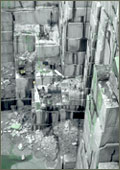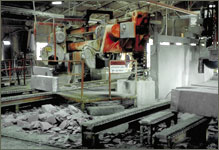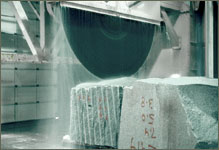Occupational Traditions – Granite Quarrying
Much of New Hampshire's bedrock is granite.

Workers appear
as small as ants
in the depths of
Swensons
Granite Quarry,
Rattlesnake Hill,
Concord.
Its density and patterns are the result of millennia of compression deep in the earth's crust. During the last ice age, glaciers scraped over the landscape of New Hampshire, revealing its stone foundation, scraping gouges and leaving rocks and boulders of every size and shape randomly flung across the countryside.
New Hampshire makes good use of its granite. Granite stone walls, curbs, buildings, and even a few bridges can be found throughout the state. Though granite outcroppings are visible from roads and fields, commercial-grade granite must be cut from solid deposits underground, where the effects of wind and ice have not damaged the stone. At one time small quarries were common in southern New Hampshire, but today only larger sites produce enough stone to be worth the cost of operation.
The largest quarry in New Hampshire is in the center of Rattlesnake Hill, just outside the state capital, Concord. Swenson Granite Company was established in 1883 and today is headed by the fifth generation of the Swenson family, brothers Kevin and Kurt.
Quarrying granite is difficult and dangerous, even today. Though some of the technology has changed, quarry workers continue to apply their skill and strength to cutting 30 x 30 x 12-foot blocks from the rock face one at a time. These blocks in turn are split into smaller 20-ton slabs before being hoisted out of the pit.
The blocks are hauled to a large sawing room where they are cut by a diamond-tipped saw, 12 feet in diameter. Controlled by computer precision, the blade sweeps across the block, cutting it 3 inches deep at a pass. These slabs then move to the cutting shed, where they are split into curb-size pieces by a hydraulic splitter. Curved curbing and round domes are still cut by hand.
The Concord quarry produces about 25,000 tons annually in its year-round operation. Quarried at the present rate, there is an almost inexhaustible supply of granite. Street curbing is the quarry's mainstay, and it cuts about 330,000 linear feet a year. A retail store at the quarry also sells granite benches, gate posts, birdbaths and palettes of split and field stone for stone wall building.
New Hampshire granite has journeyed to many places in the world to become part of monumental buildings. One of the most notable is the Library of Congress in Washington, DC, which was built from over 30,000 tons of New Hampshire granite. Boston's Quincy Market was also made of New Hampshire granite.
Special note: In 1999 Swenson's Granite Quarry provided 27 tons of New Hampshire granite to beautify the site of New Hampshire's presentation at the Smithsonian Folklife Festival in Washington DC. Over 30 tons were provided for the expanded recreation at the Celebrate NH Festival.

Street curbing is cut with
hydraulic splitters, much the
way wood is split with an axe.

Computers line up the blades
for the start of each 3-inch cut
of a 12-foot diamond-tipped saw at
Swenson's Granite Quarry.
Water washes away the dust
and cools the blade.
Photo credit: Lynn Martin Graton
New Hampshire State Council on the Arts
19 Pillsbury Street - 1st Floor, Concord, NH 03301


